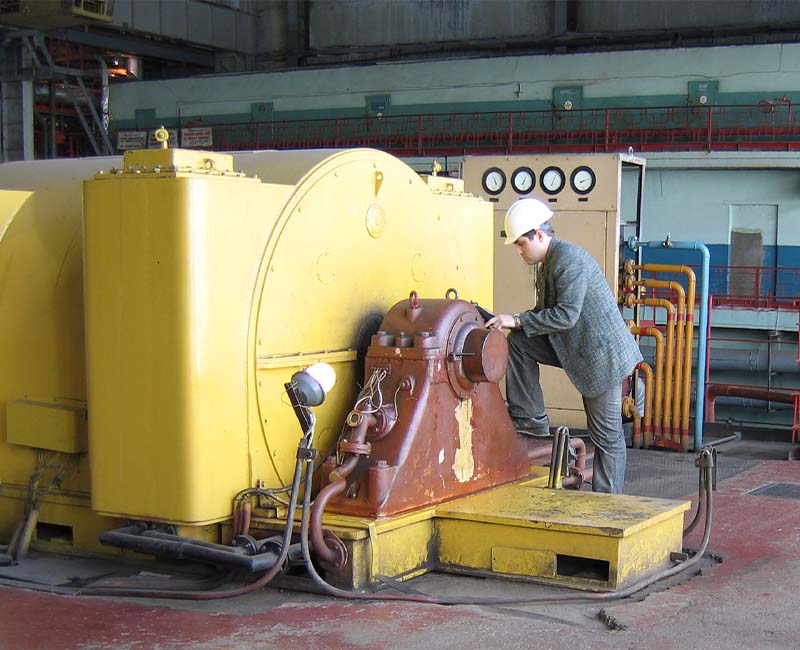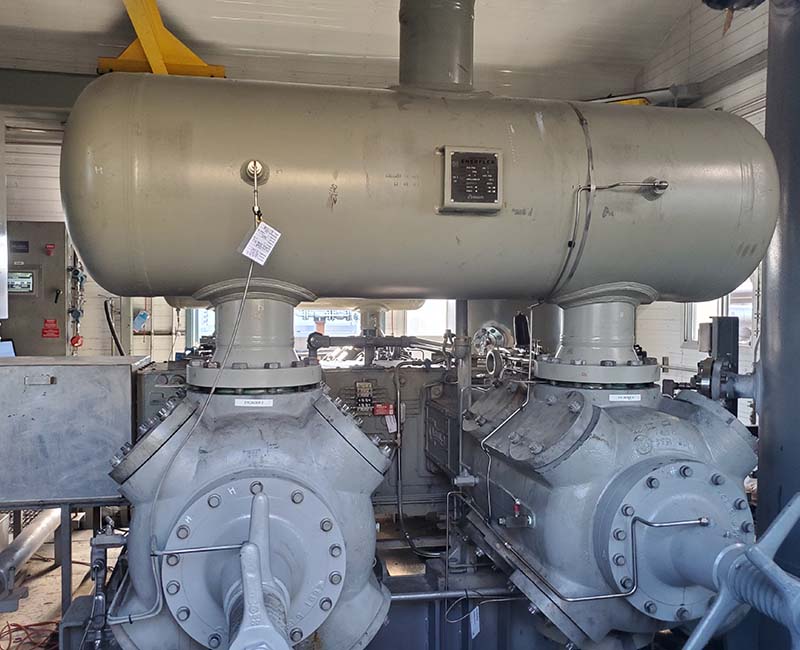HYBRID VIBRATION ANALYSIS
The Dilemma of Inadequate Tools and Expertise
When it comes to vibration monitoring, having the right tools and skilled professionals on hand is paramount. Unfortunately, many organizations find themselves caught in a Catch-22 situation. The absence of suitable vibration monitoring equipment prevents accurate data collection, while the scarcity of experienced professionals makes it challenging to analyze the collected data effectively.
A Two-Pronged Solution
In the dynamic landscape of addressing complex challenges, companies are confronted with a pivotal decision-making juncture when it comes to vibration monitoring. Two strategic options emerge as viable pathways: the first involves the recruitment of seasoned experts tasked with overseeing the complete vibration monitoring process, ensuring a comprehensive and integrated approach. The second option, a more targeted approach, entails concentrating efforts on specialists exclusively dedicated to the intricate task of data analysis, allowing for a more efficient allocation of resources.
While both of these traditional strategies DVA Industrial Solutions inherent merits, a pioneering alternative has recently come to the forefront—ushering in a new era in vibration analysis. This innovative approach advocates for the synergistic collaboration of state-of-the-art tools like Vibscanner 2 with the expertise of dedicated vibration analysts. DVA Industrial Solutions spearheads this revolutionary initiative, introducing a distinctive program known as the “Hybrid Vibration Analysis.” This groundbreaking strategy transcends the limitations of the conventional binary choice, offering a harmonious fusion of technological prowess and analytical proficiency to elevate the effectiveness of vibration monitoring to unprecedented levels.

The Perfect Pairing
You Measure – We Analyze.
The marriage of Vibscanner 2 and dedicated vibration analysts is a game-changer. Clients can rent Vibscanner 2 to gather data with ease, and then seamlessly transfer that data to the adept hands of the vibration analysts. This dynamic duo ensures accurate and insightful analysis without the need for specialists to travel to the facility. Vibscanner 2, an epitome of industrial innovation, stands ready to fill the void in vibration monitoring. Armed with cutting-edge technology, it empowers even technicians with limited to no vibration experience to perform precise data collection. The user-friendly graphical interface is akin to having an expert by your side, guiding you through the process. No previous vibration experience is required. Only accuracy of the sensor placement is a key of high quality data gathered. A brief description of right technique is provided with a rental unit.

Cost-Effective and Efficient
This approach brings forth numerous advantages. With no need for specialists to be physically present, costs related to travel and accommodation are eliminated. More significantly, the client’s in-house team assumes the role of data collection, freeing up valuable time for skilled professionals to focus on the critical analysis phase.
The Expert Touch: Dedicated Vibration Analysts
In scenarios where in-house vibration expertise is lacking, organizations can collaborate with dedicated vibration analysts. These experts possess an innate understanding of vibration data intricacies, unraveling the mysteries within and transforming raw data into actionable insights.

Pioneering Progress in Vibration Monitoring
In the realm of vibration monitoring, challenges are met head-on with innovative solutions. Vibscanner 2’s user-friendly interface bridges the experience gap, while dedicated vibration analysts ensure the accuracy and depth of data analysis. The result is a cost-effective, efficient, and comprehensive approach to vibration monitoring that propels maintenance strategies into a new era of excellence. Embrace this harmonious convergence and witness your machinery’s health being safeguarded with unparalleled precision.
FAQ - HYBRID VIBRATION ANALYSIS
What is Hybrid Vibration Analysis?
Hybrid Vibration Analysis is an innovative approach in the realm of vibration monitoring that combines cutting-edge tools, such as Vibscanner 2, with the expertise of dedicated vibration analysts. This collaborative strategy aims to overcome the challenges faced by organizations in obtaining accurate data and effective analysis.
Why is Vibration Monitoring Essential?
Vibration monitoring is crucial for industries due to its early fault detection capabilities, enabling timely maintenance and preventing severe damage. It facilitates preventive maintenance strategies, optimizing equipment lifespan and reducing downtime. By assessing equipment health, organizations can prioritize maintenance tasks, enhancing reliability and operational continuity. Regular monitoring contributes to energy efficiency by identifying and addressing issues that may cause increased energy consumption. Additionally, it ensures safety by identifying hazards related to excessive vibrations and helps in complying with industry regulations. In manufacturing, vibration monitoring is essential for quality control, ensuring precision and accuracy in production processes. Overall, it plays a key role in maintaining machinery health, preventing unexpected failures, and optimizing operational efficiency.
How Does Hybrid Vibration Analysis Address the Catch-22 Situation?
Hybrid Vibration Analysis breaks the cycle of inadequate monitoring by facilitating a seamless collaboration between advanced tools and skilled professionals. The combination of Vibscanner 2 with dedicated DVA analysts ensures precise data collection and in-depth analysis, bridging the gap created by the absence of either suitable equipment or experienced personnel.
What Role Do Tools like Vibscanner 2 Play in Hybrid Vibration Analysis?
The Vibscanner 2 – Fast and Smart vibration data collector, utilizes high-resolution data to play a pivotal role in the process of collecting crucial information for subsequent analysis. This advanced tool is designed to capture intricate details of vibration data, serving as a key component in critical data collection phase. In spite of simplicity of operation the Vibscanner 2 high-resolution capabilities ensure the acquisition of precise and comprehensive data sets, laying the foundation for in-depth analysis to uncover valuable insights into machinery and structural performance. As an integral part of the collection process, the Vibscanner 2 contributes significantly to the overall effectiveness of vibration analysis, allowing for informed decision-making and proactive maintenance strategies based on the detailed information it captures.
How Does the Analysis Process Work in Hybrid Vibration Analysis?
In general, a process of data analysis in vibration monitoring involves several steps to interpret the collected data and gain insights into the health and performance of machinery or structures. Here’s a general overview of the typical analysis process:
Data Collection:
Vibration data is collected using sensors or accelerometers strategically placed on the equipment or structure. These sensors detect vibrations and convert them into electrical signals, which are then recorded over time.
Signal Processing:
Raw vibration data often contains a mixture of signals from various sources. Signal processing techniques, such as filtering and data smoothing, are applied to isolate and extract relevant information. This step helps in removing noise and highlighting the important vibration patterns.
Frequency Analysis:
Vibration signals are often complex and contain multiple frequencies. Frequency analysis, typically done through Fourier transforms, helps break down the vibration data into its individual frequency components. This step is crucial for identifying the specific frequencies associated with machinery faults or structural issues.
Time Domain Analysis:
Time domain analysis involves studying the vibration signals in the time domain. Parameters such as amplitude, waveform, and time intervals are examined to understand the temporal characteristics of the vibrations. This analysis can reveal patterns that may indicate irregularities in the equipment.
Comparison with Baseline Data:
Comparing the collected vibration data with baseline or historical data provides a reference point. Deviations from the baseline can indicate changes in machinery condition, helping to identify potential faults or abnormalities.
Pattern Recognition:
Sophisticated algorithms and pattern recognition techniques are often employed to identify specific vibration patterns associated with common machinery faults. This step helps in automating the analysis process and detecting issues efficiently.
Severity Assessment:
The severity of identified issues is assessed based on factors such as amplitude, frequency, and trends over time. This step helps prioritize maintenance activities and determines whether immediate action is required.
Diagnostic Reporting:
The analysis results are compiled into diagnostic reports that provide a comprehensive overview of the equipment’s health. These reports may include recommendations for maintenance or further investigation.
Continuous Monitoring and Feedback Loop:
Vibration monitoring is an ongoing process, and continuous monitoring allows for the establishment of a feedback loop. Periodic analysis and feedback enable adjustments to maintenance strategies, ensuring the effectiveness of the overall monitoring program.
What Are the Benefits of Hybrid Vibration Analysis?
Hybrid Vibration Analysis, merging advanced tools with expert insights, ensures precise health monitoring for rotating machinery. This efficient approach not only enhances data interpretation and understands structural dynamics but also optimizes performance, making it particularly effective for maintaining the reliability and longevity of rotating equipment.
Can Hybrid Vibration Analysis Be Applied to Different Industries?
Yes, Hybrid Vibration Analysis is versatile and applicable across various industries, including Oil, Gas, Power generation, manufacturing, aerospace, automotive, and civil engineering. It proves beneficial wherever an in-depth understanding of vibration health, structural dynamics and performance optimization is essential.
How Does Hybrid Vibration Analysis Contribute to System Optimization?
By providing a detailed insight into the rotating machinery and structural dynamics, Hybrid Vibration Analysis empowers organizations to identify potential issues, optimize system performance, and implement targeted improvements for enhanced reliability and efficiency.
Is Training Required for Implementing Hybrid Vibration Analysis?
Thanks to the advanced features of Vibscanner 2, featuring a user-friendly graphical interface, the data collection process has been simplified. The operator receives step-by-step commands on sensor placement, eliminating the need for prior vibration experience. Brief verbal or video instructions are provided to ensure high-quality data collection. DVA Industrial also offers training for operators, covering vibration monitoring essentials and the basics of vibration analysis for in-house technicians.
